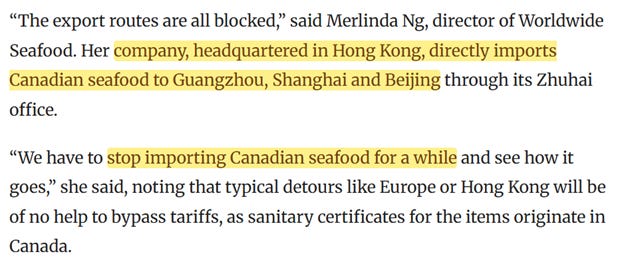Bullets:
The Canadian lobster industry is suffering major losses, after high tariffs from China have closed off exports to the world’s largest lobster importer.
Thanks for reading Inside China / Business! Subscribe for free to receive new posts and support my work.
Earlier this year, China’s Commerce Ministry announced 25% tariffs on Canadian lobster, in retaliation for Canadian tariffs on Chinese cars, steel, and aluminum.
Lobster prices collapsed, and are now cheaper than beef, as Vietnam’s lobster sales to China skyrocketed, increasing over 30 times.
China also relaxed earlier restrictions on Australian lobster imports.
Lobstermen in Canada are desperate for a diplomatic solution before the Chinese market is lost permanently. They are dependent on sales to the United States, also a major producer of lobster, where consumer sentiment is at record lows.
This is a transcript, for the YouTube video here:
Report:
Good morning.
China is already the world’s largest producer of farmed fish, and has a large industry for growing lobsters. But it’s not nearly enough to meet demand, and so China is the world’s largest importer of lobster. Previously, China’s biggest sources were Australia, Canada, and the United States, but now those supply chains are being scrambled up, and lobster fishermen in Canada are getting hit.
Earlier this year China put high tariffs on imports of Canadian lobster, and President Trump threatened to do the same thing for lobster heading to the US market. Lobster prices dropped immediately.
Canadian exports of lobster to China have disappeared almost completely. This company is in Hong Kong and was previously a major buyer of Canadian lobster for the Mainland Chinese market, and they just stopped. There are also no workarounds or rerouting possible here to get around the tariffs, like we see sometimes for manufactured products, because shellfish are very highly regulated with respect to cold storage, transport, and freshness. The new Chinese tariff at 25%, plus the VAT of 13% just made Canadian lobster uncompetitive. So buyers shifted to Australia or producers in Asia.
Australia was recently allowed, again, to resume their exports of lobster to China after a few years of being locked out, so Chinese imports from there are ramping up. But the biggest change is in Vietnam. These numbers are from 2024, and compared to 2023 lobster exports from Vietnam to China were up 33 times. Vietnam now accounts for 37% of total Chinese imports of lobster.
The demand for lobster is growing like crazy in China, up huge, over 40% year over year. And this is a feature we see here again and again, that prices fall, despite booms in demand. That means that even though demand is up big, available supplies are growing even faster, than that 40% year on year number. And Vietnam is a driver of a lot of that—production costs in Vietnam are just lower than from anywhere else. China doesn’t produce nearly enough lobster to meet domestic demand, but Vietnam is the next best thing—they’re right next door, so shipping costs and time from Vietnam drop to almost nothing. Lobster can be delivered next-day fresh from Vietnam to China, and at dramatically lower costs that shipping from Australia or North America.
The tariff problem for Canada kicked off in February and March, when China’s Commerce Ministry placed retaliatory tariffs on Canadian rapeseed, seafood, and pork. Those were in response to similarly sized tariffs Canada placed on Chinese electric cars, steel, and aluminum. The trade balance between China and Canada previously was very even, the most balanced in the world, probably, and now both of those numbers are being driven lower.
In the case of Canadian lobster, the losses to the industry so far, through the nine months since, is 77 million dollars Canadian, and the director of the Seafood Alliance in Nova Scotia is desperate for a diplomatic solution, fast, or the Chinese market will be forever gone to fishermen there.
President Trump did not follow through on his threat to put tariffs on Canadian lobster, which would have devasted the industry. But the damage is already done on the pricing side because of the 25% tariff on everything going to China. Lobster is less expensive than steak—in both markets—which tells you how bad things are in the seafood industry, and also how bad things are for buyers of beef.
With the Chinese market gone, Canadian lobstermen are dependent on Trump’s attention being on something else, and on the health of the American economy. And that’s in trouble too—consumer confidence in the US is at historic lows, similar to levels seen during the pandemic, and even lower than when the financial system blew up in 2008.
Resources and links:
South China Morning Post, Canada’s lobster exporters feel the pinch as China’s tariffs snip prices
SCMP, Canada’s dual tariff battles with US and China threaten to strain world trade system
Lobster industry breathes sigh of relief as tariff threat walked back for now
Canadian lobster industry takes CAD 77m hit from Chinese tariffs
SCMP, Vietnamese lobsters claw back to prominence in China after temporary dip
China Resumes Live Rock Lobster Imports from Australia
Thanks for reading Inside China / Business! Subscribe for free to receive new posts and support my work.
From Inside China / Business via this RSS feed






